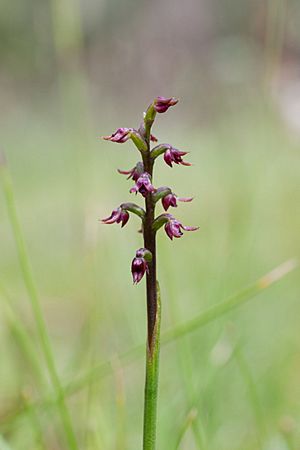Tiny midge orchid facts for kids
Quick facts for kids Tiny midge orchid |
|
|---|---|
 |
|
| Genoplesium nudum growing in Namadgi National Park | |
| Scientific classification | |
| Genus: |
Genoplesium
|
| Species: |
nudum
|
| Synonyms | |
|
|
The Genoplesium nudum, also called the tiny midge orchid in Australia and the red midge orchid in New Zealand, is a small plant. It is a type of orchid that grows on the ground. This orchid is found naturally in south-eastern Australia and New Zealand.
It has one thin leaf that is joined to its flower stem. The plant can have up to forty small flowers. These flowers are usually reddish-purple or a mix of green and red. Different plant experts use slightly different names for this orchid. Some call it Corunastylis nuda, while others use Genoplesium nudum.
Contents
What the Tiny Midge Orchid Looks Like
The tiny midge orchid is a plant that grows from an underground tuber, which is like a small storage root. It is a perennial plant, meaning it lives for more than two years. It is also deciduous, so its leaves might fall off at certain times.
Each plant has a single, thin leaf. This leaf can be about 150 to 300 millimeters (6 to 12 inches) long. Part of the leaf is attached to the flowering stem. The free part of the leaf is about 10 to 20 millimeters (0.4 to 0.8 inches) long.
The plant grows a flowering stem that is about 50 to 100 millimeters (2 to 4 inches) tall. On this stem, you can find between five and forty flowers. These flowers are often reddish-purple or green and red. They are small, about 4.5 millimeters (0.18 inches) long and 3 millimeters (0.12 inches) wide. They often do not open all the way.
The flowers are unusual because they are "inverted." This means a part called the labellum is above the column, instead of below it. The dorsal sepal (a leaf-like part) is egg-shaped and about 2 millimeters (0.08 inches) long. The lateral sepals are longer, about 3 millimeters (0.12 inches) long. They are joined at the bottom and then curve downwards.
The petals are egg-shaped and about 1.5 millimeters (0.06 inches) long. The labellum is thick and fleshy, also about 1.5 millimeters long. It has tiny teeth along its edges. There is a special raised area called a callus in the middle of the labellum.
In Australia, these orchids usually flower between December and March. In New Zealand, they flower a bit later, until August.
How the Tiny Midge Orchid Got Its Name
The tiny midge orchid was first officially described in 1853. A scientist named Joseph Dalton Hooker gave it the name Prasophyllum nudum. He wrote about it in a book called Flora Novae-Zelandiae.
Later, in 1989, two other scientists, David Jones and Mark Clements, changed its name to Genoplesium nudum. Then, in 2002, they changed it again to Corunastylis nuda.
The second part of its scientific name, nudum, comes from a Latin word. It means "bare" or "naked." This might refer to how simple or small the plant appears.
Another scientist, Robert D. FitzGerald, described a similar plant in 1888 and called it Prasophyllum transversum. However, Jones and Clements later decided that this was the same plant as Genoplesium nudum.
Where the Tiny Midge Orchid Lives
The tiny midge orchid usually grows in forests where the ground is moist and grassy. You can find it in several places. In New South Wales, Australia, it grows south of the New England area. It is also found in eastern Victoria and in Tasmania.
Outside of Australia, it lives in New Zealand. You can find it on the North, South, and Chatham Islands.
Reproduction and Life Cycle
Most types of Genoplesium and Corunastylis orchids are pollinated by tiny vinegar flies. However, the tiny midge orchid is special because it is self-pollinating. This means it can pollinate itself without needing insects to carry pollen. It reproduces only by making seeds.
This orchid does not seem to need a bushfire to flower. But it often appears in places where the ground has been disturbed, like after some land clearing.
Protecting the Tiny Midge Orchid
The tiny midge orchid is quite common in most places where it grows. However, in Tasmania, it is considered "Rare." This means there are not many of them left there.
In Tasmania, the orchid is protected by a law called the Threatened Species Protection Act 1995. It is at risk in Tasmania because of things like land being cleared for buildings or farms. It is also threatened by logging activities and by fires that happen at the wrong time or are too intense.

